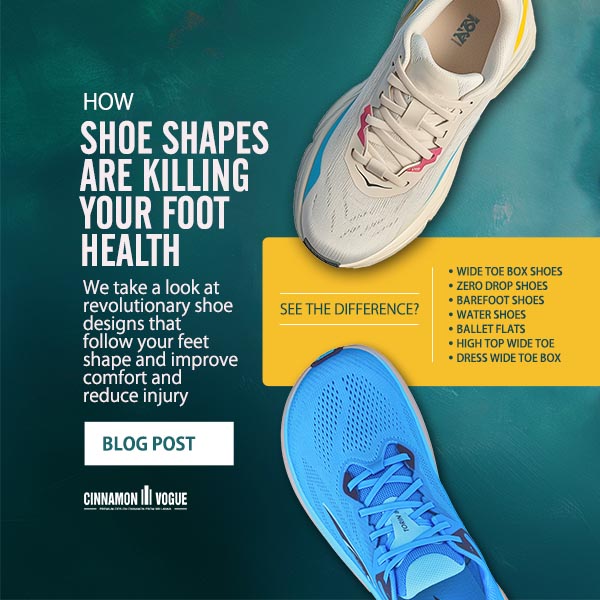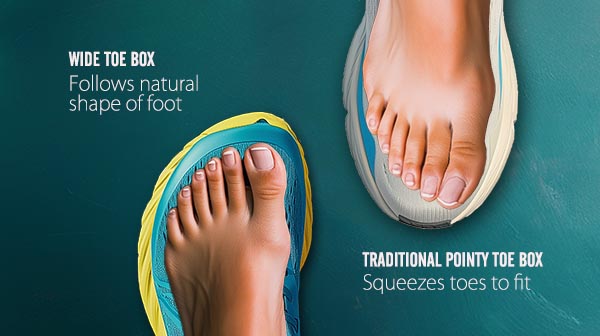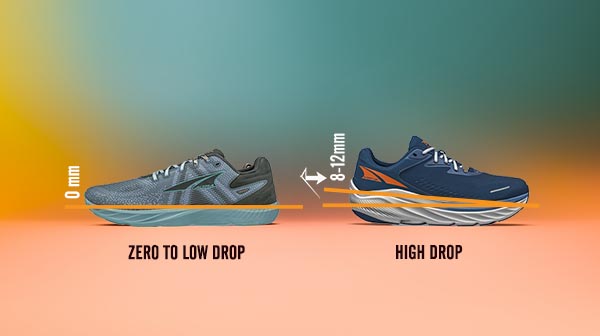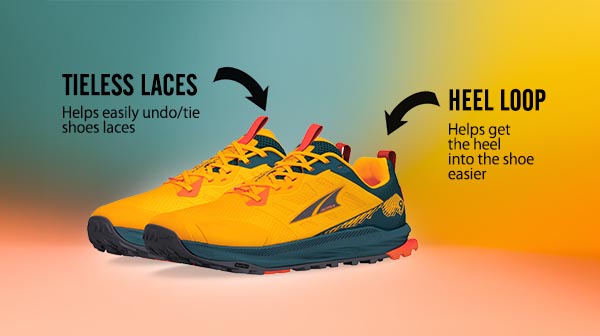Is the shape of your shoe affecting your foot health? I never really thought about shoes until I hurt my foot doing calf raises. Suddenly, walking my dog became a challenge. I bought a pair of Hokas, and while they were more comfortable, something still felt off. That got me thinking—our feet are naturally designed for walking, running, and climbing, so why aren’t shoes shaped like them?
Most shoes squeeze our toes together, causing twisted deformities. I’ve seen it firsthand. Back when I danced Argentine Tango, many women complained about foot pain from high heels. Over time, their toes would become deformed.
My “aha” moment came when I ordered a bunion corrector from Amazon. It worked surprisingly well, and that’s when it hit me: maybe our shoes are cramping our toes all day. Decades of wearing tight shoes and exercising in them had finally taken their toll.
THE STRANGE HISTORY OF CONSTRICTING FOOTWEAR
This isn’t a new problem. For centuries, people have worn shoes more for fashion than function:
- Medieval Europe (14th-15th Centuries): Wealthy men wore poulaines—shoes with ridiculously long, pointy toes—until they were banned in 1463.
- China’s Foot Binding: Women were expected to have small feet, leading to the painful and harmful practice of foot binding.
- High Heels in Persia and Europe: Persian cavalry wore heels to stay in stirrups, a trend that reached European nobility. King Louis XIV of France popularized red-soled heels as a status symbol. Women later adopted them to emulate elite men’s fashion.
The trend of pointy, narrow shoes has continued through the centuries, often linked to status, elegance, and fashion—despite the discomfort.
SQUARE-TOED SHOES: A GLIMMER OF HOPE
Thankfully, there have been times when shoes followed the foot’s natural shape:
- 16th-17th Centuries: Broad, square-toed shoes were common, offering more room for toes.
- 1920s Flapper Era: Women wore sturdy shoes with square toes to dance the Charleston comfortably.
- 1960s-70s: Square-toed boots and platform shoes became popular with mod fashion and disco trends.
- 2020s Comeback: Brands like Bottega Veneta revived square-toed designs, proving that comfort and style can coexist.
WHY MOST SHOES IGNORE FOOT ANATOMY
1. Fashion Over Function
We’ve been conditioned to think narrow, pointy shoes look better—even if they hurt. High heels push weight onto the balls of our feet, leading to long-term damage. But I believe stylish shoes can be designed to match the foot’s natural shape.
2. Production Challenges
Mass-producing shoes for every foot shape is complicated and expensive. Still, brands like Nike produce countless designs—so it’s possible. Companies like Hoka and On have already shown that comfort and style aren’t mutually exclusive. New players like Altra have taken it to another level with wide toe box and zero drop shoes.
3. Consumer Perception
Even when natural-shaped shoes are available, people hesitate. I remember wearing wide sneakers, and my sister-in-law called them “old man shoes.” Sadly, many choose to fit in rather than prioritize comfort. Marketing plays a role too—pointy, narrow shoes are seen as elegant, while wider shoes are often labeled as “clunky.”
WHY CHOOSING FOOT-SHAPED SHOES MATTER
Ignoring proper footwear can have serious long-term effects. Poorly designed shoes can lead to:
• Chronic foot pain
• Knee, hip, and lower back issues
• Bunions, corns, and calluses
• Poor posture and gait abnormalities
On the other hand, switching to foot-shaped footwear can improve balance, reduce pain, and even reverse some common foot deformities.
DIFFERENCE BETWEEN TYPES OF SHOES
Wide Toe Box Shoes:
Wide toe box shoes are designed with extra space in the front of the shoe, allowing your toes to spread naturally. This design reduces pressure on the toes, improves balance, and can help prevent foot issues like bunions, hammertoes, and neuromas. They’re ideal for people with wider feet, foot conditions, or those seeking more comfort during daily activities.
Wide Toe Box Shoes vs. Regular Sneakers
| Feature | Wide Toe Box Shoes | Regular Sneakers |
|---|---|---|
| Toe Space | Allows toes to spread naturally | Constricts toes, often causing crowding |
| Comfort | Reduces pressure and hot spots | May cause discomfort with prolonged wear |
| Balance & Stability | Improved due to full toe splay | Less stable with restricted toe movement |
| Foot Health | Can help prevent bunions, hammertoes, and neuromas | May worsen or contribute to foot deformities |
| Posture & Alignment | Supports natural foot alignment | Can lead to compensatory posture issues |
| Performance | Enhances balance in activities like lifting and yoga | Less ground feel, may reduce movement efficiency |
| Injury Prevention | Lowers risk of blisters and certain overuse injuries | May increase risk of toe-related injuries |
| Adaptation Time | Minimal (unless paired with zero-drop) | No adjustment needed if already accustomed |
| Ideal For | Walking, hiking, lifting, barefoot lifestyle seekers | General use, fashion, high-impact sports |
Zero Drop Shoes:
Most traditional sneakers are not zero-drop. They typically have a heel-to-toe drop of 8–12 mm to provide extra cushioning, especially for runners who heel-strike.
Benefits of Zero-Drop Shoes:
- Promotes natural posture and alignment.
- Encourages a midfoot or forefoot strike when running.
- Can reduce stress on knees and hips (when used correctly).
- Strengthens foot muscles over time.
| Feature | Zero-Drop Shoes | Regular Sneakers |
|---|---|---|
| Heel Height | Same as forefoot (0 mm) | Higher than forefoot (8–12 mm) |
| Posture Impact | Promotes natural alignment | May tilt posture forward |
| Use Case | Barefoot running, lifting, casual wear | General running, sports, everyday comfort |
| Transition | Requires gradual adaptation | No transition needed |
Important Tips:
- Transition gradually to avoid Achilles or calf strain.
- Start with short walks or low-impact workouts.
- Stretch calves and feet during the transition.
While most zero drop shoes have a wide toe box, not all are. Zero-drop sneakers are a specific category, often found in Minimalist running shoes (e.g., Altra, Xero Shoes, Merrell Barefoot series), Cross-training shoes (for better stability during lifting) and some casual shoes.
Some brands offer narrower options in their zero drop options for activities requiring a snug fit (like running or climbing):
- Merrell Barefoot series – Often has a slimmer fit.
- Vivobarefoot performance models – Tend to be narrower.
- Xero Shoes (HFS & 360) – Secure fit without excessive width.
- Topo Athletic – Zero-drop with moderate width (wider than traditional shoes but narrower than Altra).
Traditional Shoes:
Traditional shoes typically have a narrower toe box and often include elevated heels, arch support, and cushioning. While these features may offer initial comfort and structure, the narrow front can compress toes, potentially leading to discomfort or long-term foot problems. Traditional shoes are commonly used for both formal and casual wear.
Barefoot Shoes:
Barefoot shoes mimic the feeling of walking barefoot while providing minimal protection for the soles of your feet. They do feature a wide toe box, zero drop (no difference in height from heel to toe), and thin, flexible soles to promote natural foot movement, strengthen foot muscles, and improve proprioception. They are often favored by those seeking a more natural gait and foot function. But be warned these shoes in my opinion are uncomfortable for daily use like going on a walk, hiking, going to the shopping mall or doing every day chores. They are best for the beach, walking around the house, at the pool or use on a boat in my opinion.
Water shoes :
Very similar to barefoot shoes but they serve different purposes and have distinct features:
- Purpose: Designed specifically for water activities like swimming, boating, kayaking, or walking on slippery, rocky surfaces.
- Features:
- Quick-drying materials (like mesh or neoprene)
- Drainage holes to expel water
- Slip-resistant soles for wet surfaces
- Often snug-fitting to stay secure in water
- Use Cases: Beach outings, water sports, river hiking, and activities where your feet are frequently wet.
Watch the video below for an interesting discussion about shoes.
BRANDS THAT GET IT RIGHT (AND THOSE THAT DON’T)
Brands That Prioritize Fashion Over Comfort:
- Christian Louboutin, Jimmy Choo: Stylish but foot-cramping.
- Nike & Adidas (mainstream lines): Focus more on performance and aesthetics.
- Allen Edmonds: Traditional, narrow dress shoes.
Brands That Respect Foot Anatomy:
- Vivobarefoot
- Xero Shoes
- Lems: Wide toe boxes, flexible soles.
- Altra Running: “FootShape™” design allows natural toe splay.
- Topo Athletic: Foot-shaped with supportive cushioning.
However all these brands very expensive. Often in excess of $150. But there are simple no frills brands on Amazon that will do the trick for much cheaper. Here is what we found.
- Whitin - Prices from $36.99 to about $50. And they even have flip flops.
- Pulltop – Prices from $39 – $42
- Joomra Prices from $14.99 with a great selection of toddler shoes.
STUDIES ON WIDE TOE AND ZERO DROP SHOES
Wide Toe Box Shoes:
-
Reduced Forefoot Pressure: A study published in the Journal of Foot and Ankle Research found that the shape of a shoe’s toe box significantly influences pressure on the forefoot. Shoes with a wider toe box allow toes to splay naturally, reducing pressure and potentially decreasing the risk of conditions like bunions and corns. pmc.ncbi.nlm.nih.gov
-
Enhanced Comfort and Mobility: Research indicates that wide toe box shoes improve comfort by preventing toe deformities and enhancing balance and mobility. This natural toe splay supports better posture and reduces reliance on corrective footwear. pinnaclehillchiropractic.com
-
The study “Footwear choices for painful feet – an observational study exploring footwear and foot problems in women” found
-
Age and Footwear Type: Women over 61 years old predominantly chose slip-on shoes.
-
Shoe Width and Foot Pathology: This older group often wore shoes narrower than their feet, a mismatch correlated with the presence of Hallux Abductovarus (HAV), a common toe deformity.
-
Footwear Advice: The study highlighted the necessity for personalized footwear guidance, as the shoes worn to podiatry appointments didn’t always reflect daily footwear choice
-
My Dad had these issues. Why do older people prefer slips on shoes? My theory is they cannot bend down. To solve this problem I suggest wide door box shoes with a little heel loops (good shoes have these features already built in) that helps get your heel into the shoes and laces with tieless shoes laces. You can even buy tieless laces for shoes like these on Amazon.
Zero Drop Shoes:
-
Improved Running Economy: A study in the Journal of Sports Medicine reported that transitioning to minimalist footwear, which often features a zero drop design, can improve running economy. However, the study also noted an increased risk of calf and shin pain, emphasizing the need for a gradual transition. pmc.ncbi.nlm.nih.gov
-
Natural Foot Positioning: Zero drop shoes promote a natural foot position by aligning the heel and forefoot at an equal level. This design can enhance posture and encourage a more natural gait, potentially reducing stress on the knees and lower back. lemsshoes.com
Raised Toe Box Shoes:
-
Reduce the risk of toe injuries: Noticed many shoes have a raised toe box? This study reported a significant reduction in degree of toe deformation and potential biomechanical changes during the loading phase. If you running then this type of design must be considered. pmc.ncbi.nlm.nih.gov
POSITIVE TRENDS AND SOLUTIONS
Minimalist Shoe Movement: Brands now offer shoes that mimic walking barefoot, strengthening foot muscles and improving balance.
Custom and 3D-Printed Shoes: Companies like Feetz and Wiivv use 3D scanning to create perfectly fitted shoes—though they’re pricey.
Orthopedic Brands: Birkenstock and Orthofeet focus on comfort with supportive features, even if they don’t fully match foot shape.
HOW TO PICK THE RIGHT SHOE
Finding the right shoes can be difficult. What we looked at was primarily sneakers, especially sneakers that offer a wide toe box that follows the shape of your foot. But you can get wide toe box shoes for men’s dress shoes, women high heels, toddler and kids shoes too. We found this sneaker review site that rates sneakers which is quite impressive.
While we as adults think about our comfort we should also pay attention to the shoes our children wear, especially toddlers. Wearing wide toe box, zero drop shoes can significantly benefit the natural development and long-term health of growing feet. Here’s how they help across different age groups:
Toddlers:
- Natural Foot Development: Allows toes to splay naturally, promoting proper bone growth and muscle development.
- Improved Balance & Coordination: Flat soles (zero drop) help toddlers maintain stability as they learn to walk.
- Strengthens Foot Muscles: Encourages natural foot movement, reducing the risk of weak arches or flat feet.
- Prevents Toe Deformities: Reduces the chance of developing bunions or overlapping toes early on.
Kids:
- Enhanced Posture & Alignment: Zero drop design promotes proper spinal alignment, reducing strain on joints.
- Better Movement & Flexibility: Wide toe boxes prevent constriction, allowing feet to function optimally during play.
- Lower Injury Risk: Improved foot mechanics can prevent common issues like plantar fasciitis or shin splints.
- Supports Natural Gait: Encourages a midfoot or forefoot strike, which is gentler on growing joints.
Teens:
- Promotes Long-Term Foot Health: Reduces the risk of chronic foot issues that often stem from poorly designed footwear.
- Improves Athletic Performance: Natural foot movement enhances agility, speed, and balance in sports.
- Prevents Postural Problems: Helps maintain healthy posture during growth spurts.
- Reduces Common Teen Foot Issues: Can alleviate growing pains, heel pain (Sever’s disease), and ingrown toenails.
Here are are wide toe box examples we found for some major shoe categories.
- Wide Toe Box Sneaker : These Altra running shoes shows how how foot shape shoes look like. They divide it into original, standard and slim with zero drop.
- Wide Toe Box Toddler Shoe : We found these Xero shoes ($65) for toddlers and cheaper alternative like these Lelsflt shoes ($19) on Amazon
- Wide Toe Box Men Dress Shoe : These Deer stags Williamsburg ($85) shoes seems the closest to a wide toe box shoes we could find or these 1Tazero shoes on Amazon which is a proper wide toe box shoes ($62), albeit the design is not exactly fancy enough for a high level business meeting.
- Wide Toe Box women’s dress shoe : I kind of like these Stegmann Shoes ($150) which look classy without looking old fashioned. Or these high heel Calla shoes ($260) which are a wide toe box and look pretty classy.
CONCLUSION
Finding the right wide toe box shoe can be difficult. Some wide toe box shoes are not quite as wide as they claim. I would rather get a wide toe box shoe with padding or substantial cushioning over barefoot shoes. Don’t get me wrong—barefoot shoes, especially waterproof or quick-dry ones, are useful for the beach. I used them on vacation when I would jump onto the sand, onto the boat, or go for a swim.
Then we have the question of cost. Most emerging wide toe box shoes are expensive. But there are many inexpensive wide toe box shoes on Amazon, which is a good place to start. If you like wide toe box shoes, you can buy the more expensive ones later. But some of the inexpensive brands are surprisingly good. Sift through the reviews to find the right one.
Shoes should fit our feet—not the other way around. With thoughtful design and a shift in consumer mindset, stylish, foot-friendly shoes are possible. Why settle for discomfort when we can have both comfort and style? But you also have to change your mindset and follow function over fashion. I have to say, some of the wide toe designs are actually pretty darn nice-looking.




